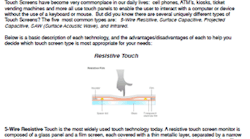Touch screens are everywhere in our daily lives: cell phones, ATM’s, kiosks, hotels and more. They enable the user to interact with a device or machine without the use of a keyboard or mouse.
But did you know that there are several different types of touch screens, each with its own unique advantages and capabilities? The five most common types are: 5-Wire Resistive Touch, Surface Capacitive, Projected Capacitive, SAW and IR.
Touch screens play a very important role in a wide range of industrial manufacturing, packaging, process control, inspection and quality monitoring applications.
This whitepaper will connect you to an article and comparison chart which will outline the key advantages, benefits and limitations of each touch screen type.
